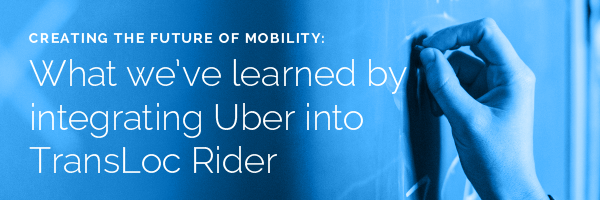
So what have we learned?
We probably launched too late.
Reid Hoffman, the founder of LinkedIn, often remarks that you should be embarrassed by your first version of a product. By that metric, we probably launched too late. Are there things that aren’t perfect about it? Of course. But we weren’t embarrassed by it. Part of that is due to our market (governments tend to be more conservative than individuals) and part of that is the nature of the product (we didn’t want anyone stranded by the side of the road).
But the larger lesson Reid was advocating was that it’s better to create quickly, release, test, and repeat rather than code in isolation for a year and then release. There are some things that you can only find out through trial and error. Case in point: we were smart enough to encourage new users of the app to try out the new functionality, but we neglected to include a similar workflow for existing app users. Far fewer current Rider users clicked on the new functionality than we had predicted.
We were too conservative.
Our clients are public transit agencies and we wanted to be careful in how we help them transition to becoming “mobility” agencies—after all, suggesting Uber to transit agencies was almost blasphemous in the beginning. There are certainly situations where an Uber trip may be more attractive than a transit ride and riders may choose that option over transit. But we’re opening doors to people who may never have or could have considered a public transit option. Transit agencies may lose the battle over a singular trip, but by giving riders the choice, they’ll win the war by helping to create the future of mobility.
Still, as we were launching these pilots, the American Public Transportation Association released a report that confirmed that Uber and Lyft were complementary to public transit. More importantly, this report gave transit agencies increased comfort in working with Uber and Lyft.
Why does this matter? Because we made certain architectural decisions that we may not have made before. For instance, we don’t provide an Uber connection to a trip for an agency that hasn’t explicitly said yes to participating. The result is that there are many trips that don’t show an Uber connection to solve the first-mile/last-mile (FM/LM) problem—it shows walking instead—which makes it more difficult to accurately beta test.
The problem is a hard one.
Problems like the FM/LM are multi-faceted. We never believed that we had the magic bullet, we believed we were removing one barrier to eventually solving the problem. We made it clear to pilot agencies that their expectation shouldn’t be hundreds or thousands of new riders who discard their single-occupancy vehicle commute simply because we removed one barrier. We wanted agencies to recognize that multi-modality was the future and to commit to helping create that future.
So, we’ve removed one barrier, but there are many other barriers that get in the way. Barriers like payments, access, disjointed service between large metropolitan and rural areas, and the lack of a user-centric experience. In order to truly solve the FM/LM problem, we’ll have to tackle those other problems too.
That’s the next step. We’ll take what we learned during this process and use that information to quickly iterate the next version of TransLoc Rider to better meet the future mobility needs of our communities.
Want to be part of the journey? We’re always interested in forward-looking agencies and companies who want to help us solve the biggest problems in transit and mobility. Let us know if you are too.